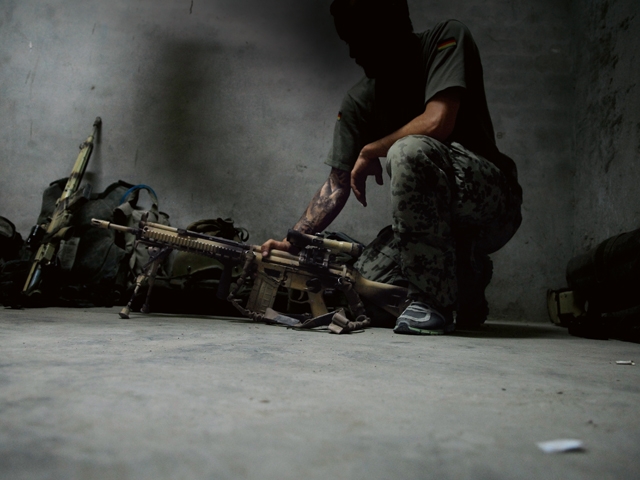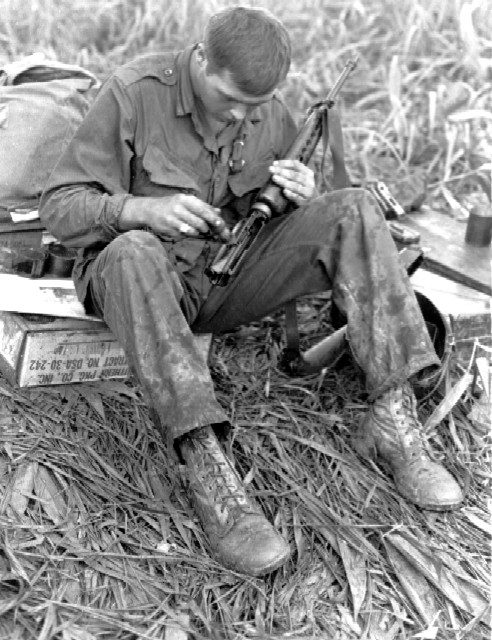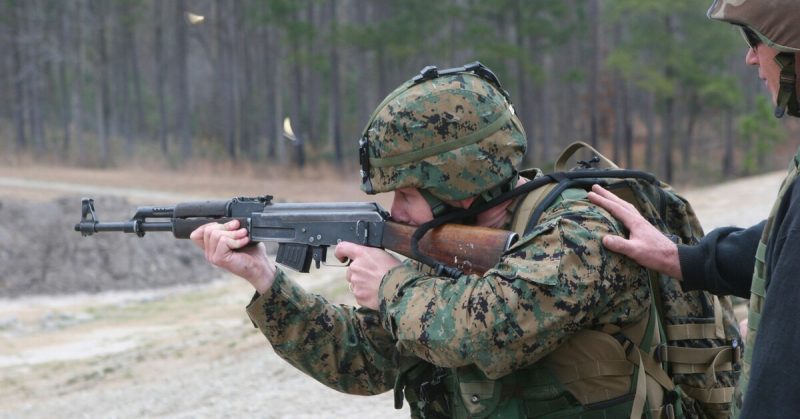Fusil Automatique Leger (FAL)
In the period after WWII, the Belgian Fabrique Nationale (FN) rapidly became a world-leading arms manufacturer. One of their most impressive weapons appeared in 1948 – the Fusil Automatique Leger (FAL).
The FAL was one of many weapons of the 1940s and 50s influenced by German developments during WWII. The Germans created the original assault rifle, the StG44, and used it to great effect during the dying days of the war. Even when working on non-automatic weapons, manufacturers from the victorious Allied powers sought to imitate the StG44’s mechanisms. They created short, light, self-loading rifles with large magazines of full-power rounds.
They were weapons for an age of skirmish-style fighting in which fast fire and stopping power were more important than having a far range.
The FAL had a 20-round detachable magazine and a gas-operated reloading mechanism that enabled soldiers to fire 30 to 40 rounds per minute. Originally designed for 7.92mm short rounds, it was adapted to use the standard NATO 7.62mm round. As weapons moved toward carrying greater volumes of smaller caliber ammunition, a 5.56mm model was also made.
One of the special features of the FAL was its quality of construction. Later moves towards cheap mass production did not affect the quality of work at the 1940s FN factory.
Heckler and Koch G3
A generation on from the FAL, Heckler and Koch introduced the G3 to the West German Army in 1959. Although part of the same genre of light rifles, the G3 benefited from advances in construction and design. Steel pressings and plastic components were used where possible. It led to a broad range of variations on the basic gun, including carbine, sniper, and light machine-gun versions.

Although lighter than the FAL, the G3 was no less sturdy or effective. The definitive assault rifle version, the G3A3, carried a 20-round box magazine and had a cycle rate of 500-600 rounds per minute when on automatic fire. It weighed just over 5kg.
Galil
Israel Military Industries Ltd produced the Galil. Like the G3 it was designed to use the 7.62mm rounds that were becoming standard in western armies. It also showed eastern influences, taking its operating system from the Soviet AK-47. It used gas tapped off the barrel to drive a piston which in turn moved the rotary locking bolt.
Originally produced in three models – the ARM multi-purpose weapon; the AR assault rifle, and the SAR short assault rifle – Israeli armed forces widely used it. It was also produced under license in South Africa and influenced Swedish designs.
AK-47
Mikhail Kalashnikov’s AK-47 assault rifle has become the most iconic infantry weapon in the world. Seventy years after it first appeared, it still serves in conflicts across the globe.
The AK-47 was produced in response to the StG44. By the time it was in service in 1946, WWII was over, but there were still more battles to be fought.
Straightforward in design and made from high-grade materials, the AK-47 was the embodiment of Soviet doctrine. Simple and functional it could be mass produced, stand the rigors of combat, and be used by almost anyone with little training. The original design carried a 30-round magazine of 7.62mm ammunition. Many other variants have since been made and exported around the world.

Steyr AUG
The Seyr Armée Universal Gewehr (UG) was the major Austrian contribution to a later style of weapons known as “bullpups.” They were a trend toward ever-lighter designs, using modern materials and short barrels. The straight shape took the recoil into the firer’s shoulder, reducing the muzzle’s tendency to rise while firing.
The AUG was designed to make maintaining weapons when in action simpler than ever. The barrel’s chrome interior made it easier to clean and less likely to wear out. Modular construction made the gun’s mechanisms easy to repair and preserve.
One of the most distinctive features of the AUG was the use of a 30-round magazine made out of clear plastic. It enabled the user to see how much ammunition they had left quite easily.
M16
Introduced in 1961, the M16 became the standard infantry weapon in America and many allied countries. Its gas-operated rotary locking mechanism was uncomplicated making it suitable for mass production.
Adapted from Eugene Stoner’s Armalite AR-15 design, the M16 fired 5.56mm Fireball rounds. It was a sign of changes in the way weapons were designed and chosen. The 5.56mm round was lighter than those that had previously been standard. It allowed troops to carry more ammunition and rely on their firepower, rather than individual bullets.
Like many other modern weapons, the M16 led to some variants, including the addition of an underslung grenade launcher.

FAMAS
The French equivalent of the AUG was the FAMAS. It was less attractive than its Austrian cousin. With a distinctive chunky sight that also acted as a carrying handle, it was an equally effective weapon. Light, reliable to use, and with a good rate of fire, it became a popular weapon. Like the AK-47 and the AUG, it was designed to be easy to manufacture and maintain – a weapon for the mass production era.
L85 Endeavour
The British bullpup weapon entered service in 1985. It’s well-designed grip, lightweight, and low recoil made it an easy weapon to use. A 30-round magazine sat near the rear of the gun.
Like other bullpup weapons, the L85 Endeavour had one significant drawback as a standard use weapon. Its ejection port was next to the firer’s cheek. As long as the operator was right-handed, it was not a problem, but if the gun was used left-handed, the ejection port burnt the user’s cheek.
Source:
Christopher Chant (1986), The New Encyclopedia of Handguns
